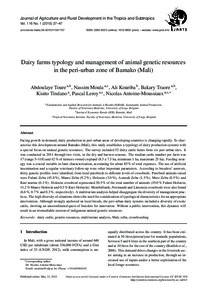| dc.date.accessioned | 2015-06-10T12:10:16Z | |
| dc.date.available | 2015-06-10T12:10:16Z | |
| dc.date.issued | 2015-05-21 | |
| dc.identifier.issn | 1612-9830 | |
| dc.identifier.issn | 2363-6033 | |
| dc.identifier.uri | urn:nbn:de:hebis:34-2015011347137 | |
| dc.identifier.uri | http://hdl.handle.net/123456789/2015011347137 | |
| dc.language.iso | eng | |
| dc.publisher | Kassel University Press | ger |
| dc.rights | Urheberrechtlich geschützt | |
| dc.rights.uri | https://rightsstatements.org/page/InC/1.0/ | |
| dc.subject | dairy cattle | ger |
| dc.subject | genetic resources | ger |
| dc.subject | multivariate analysis | ger |
| dc.subject | Mali | ger |
| dc.subject | zebu | ger |
| dc.subject | crossbreeding | ger |
| dc.subject.ddc | 630 | |
| dc.title | Dairy farms typology and management of animal genetic resources in the peri-urban zone of Bamako (Mali) | ger |
| dc.type | Aufsatz | |
| dcterms.abstract | Facing growth in demand, dairy production in peri-urban areas of developing countries is changing rapidly. To characterise this development around Bamako (Mali), this study establishes a typology of dairy production systems with a special focus on animal genetic resources. The survey included 52 dairy cattle farms from six peri-urban sites. It was conducted in 2011 through two visits, in the dry and harvest seasons. The median cattle number per farm was 17 (range 5-118) and 42% of farmers owned cropland (8.3 +/- 7.3 ha, minimum 1 ha, maximum 25 ha). Feeding strategy was a crucial variable in farm characterisation, accounting for about 85% of total expenses. The use of artificial insemination and a regular veterinary follow-up were other important parameters. According to breeders’ answers, thirty genetic profiles were identified, from local purebreds to different levels of crossbreds. Purebred animals raised were Fulani Zebu (45.8%), Maure Zebu (9.2%), Holstein (3.0%), Azawak Zebu (1.3%), Mere Zebu (0.5%) and Kuri taurine (0.1%). Holstein crossbred represented 30.5% of the total number of animals (19.0% Fulani-Holstein, 11.2% Maure-Holstein and 0.3% Kuri-Holstein). Montbéliarde, Normande and Limousin crossbreds were also found (6.6%, 0.7% and 0.3%, respectively). A multivariate analysis helped disaggregate the diversity of management practices. The high diversity of situations shows the need for consideration of typological characteristics for an appropriate intervention. Although strongly anchored on local breeds, the peri-urban dairy systems included a diversity of exotic cattle, showing an uncoordinated quest of breeders for innovation. Without a public intervention, this dynamic will result in an irremediable erosion of indigenous animal genetic resources. | ger |
| dcterms.accessRights | open access | |
| dcterms.bibliographicCitation | In: Journal of Agriculture and Rural Development in the Tropics and Subtropics. Kassel : Kassel University Press. - Vol. 116, No. 1 (2015), S. 37-47 | |
| dcterms.creator | Toure, Abdoulaye | |
| dcterms.creator | Moula, Nassim | |
| dcterms.creator | Kouriba, Ali | |
| dcterms.creator | Traore, Bakary | |
| dcterms.creator | Tindano, Kisito | |
| dcterms.creator | Leroy, Pascal | |
| dcterms.creator | Antoine-Moussiaux, Nicolas | |
| dc.description.everything | Gedruckte Ausg. im Verlag Kassel Univ. Press (www.upress.uni-kassel.de) erschienen. | ger |

